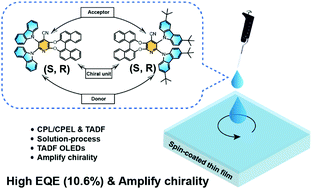Thermally activated delayed fluorescence enantiomers for solution-processed circularly polarized electroluminescence†
Abstract
Circularly polarized organic light-emitting diodes (CP-OLEDs) with thermally activated delayed fluorescence (TADF) characteristics are receiving increasing interest, as they have shown improving efficiencies of circularly polarized electroluminescence (CPEL). Here, we developed a series of TADF enantiomers based on chiral binaphthalene, an acceptor (A) of cyanopyridine, and donors (D) of carbazoles in a chiral–A–D architecture. Good solubility, high luminescence yields, and excellent chiral stability with a photoluminescence dissymmetry factor (gPL) up to 5.8 × 10−4 were achieved. Efficient CP-OLEDs using these chiral TADF molecules as dopants were successfully fabricated, exhibiting high external quantum efficiencies (EQEs) up to 12.4% and opposite CPEL signals with gEL of 6 × 10−4/−8.6 × 10−4 in vacuum-deposited devices. More impressively, the solution-processed TADF CP-OLEDs result in much larger gEL values (3.5 × 10−3/−3.9 × 10−3) with EQEs up to 10.6%. This discovery is encouraging and instructive, which could stimulate the development of high-performance CP-OLEDs using chiral TADF molecules through solution-processing approaches.



 Please wait while we load your content...
Please wait while we load your content...